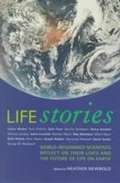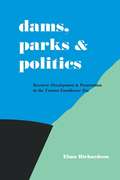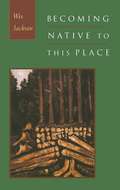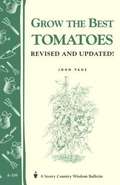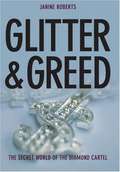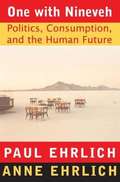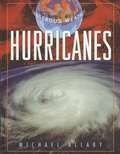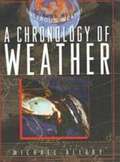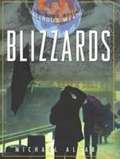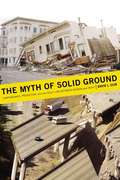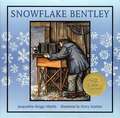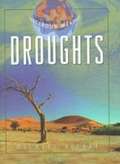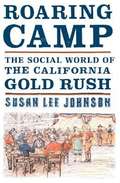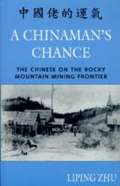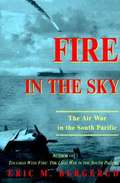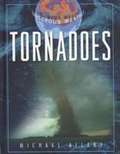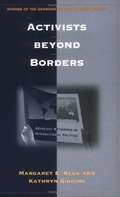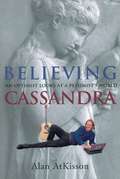- Table View
- List View
Life Stories: Well-Renowned Scientists Reflect on Their Lives and the Future of Life on Earth
by Heather Newbold"THIS BOOK IS FOR PEOPLE WHO WANT TO KNOW WHAT IS Happening to life on Earth-and to us. This knowledge is so important for our survival that I invited prominent scientists who investigate the planet's life-support system to tell their stories for our benefit. It is rare for scientists to discuss publicly their experiences, emotions, and beliefs because such expression is considered unscientific. This collection of personal and professional reflections is exceptional for its revelation of scientists' private lives and thoughts. Their profound understanding, appreciation, and reverence for life is inspirational and potentially transformative. We can experience it by following the development of their awareness, knowledge, and wisdom through their lives. These leading scientists began their careers in different scientific fields-in chemistry, nuclear physics, engineering, astronomy, and meteorology, as well as in the life sciences. In the forefront of their disciplines, they researched diverse aspects of the biosphere, yet reached convergent conclusions regarding the plight of our planet."
Waves
by Herbert S. ZimThis book talks about anything you ever wanted to know about waves, from how they are formed, explaining simple vocabulary about waves, how they travel across the oceans, how they can be destructive, and how they can be useful too. Although this book was published in 1967 I found it had some excellent information on a topic not often talked about, Ocean waves. Good read in my opinion.
Dams, Parks, and Politics: Development and Preservation In the Truman-Eisenhower Era
by Elmo RichardsonThis book is a chronicle of the myopia and gamesmanship that dominated Americans' understanding of their environment on the eve of the nation's ecology crisis. Based almost entirely on primary sources, Elmo Richardson's study examines the interplay between the national policies and programs for development and preservation of natural resources in the centralist Truman administration and the localist, enterprise-oriented Eisenhower administration. He shows that the decade examined brought about very little change in the values held by federal policy makers. Although the development of resources was a prominent issue in the elections of 1948, 1952, and 1956, what emerges from Richardson's account is the shallowness of understanding on the part of the decision makers and the public, and the ease with which policy direction could be deflected. The book demonstrates the persistence of the tradition of development and the nonpartisan character of the movement for preservation, which crossed party lines, regional lines, and economic interest groups.
Becoming Native to this Place
by Wes JacksonFrom the book: "It has never been our national goal to become native to this place. It has never seemed necessary even to begin such a journey. And now, almost too late, we perceive its necessity. Unfortunately, the nature of the nativeness toward which we must work has been not merely altered but severely compromised. Part of the reason is that we have eight and a half times as many people in our country as we did when my grandfather was born. Perhaps even worse, the forces that have given us our modern problems--the ozone hole and global warming, acid rain, Three Mile Island and Chernobyl, soil erosion and loss of family farms, and so on--gain power by the decade. Destruction is occurring at an accelerating pace. It has all happened so fast (more than 80 percent of all the oil ever burned has been burned in my lifetime) [He was born 1936.] and it is going to get worse--half of Mexico's population is under fifteen years of age, ready for a major explosion. The world is slated to add one billion people in the 1990s alone. More people will be added in ten years than the total population of the earth at the time of Columbus. This book is dedicated to the idea that the majority of solutions to both global and local problems must take place at the level of the expanded tribe, what civilization calls community. In effect, we will be required to become native to our little places if we are to become native to this place, this continent"
Glitter and Greed
by Janine RobertsThe result of 20 years research on the diamond trade and De Beers, this book reveals the myths and misinformation in the industry.
One With Nineveh: Politics, Environment, and the Human Future
by Paul R. Ehrlich Anne H. Ehrlich"Through lucid explanations, telling anecdotes, and incisive analyses, the eminent scientists Paul Ehrlich and Anne Ehrlich here spotlight the three elephants in our global living room--rising consumption, increasing world population, and unchecked political and economic inequity--that together are increasingly shaping today's politics, undermining the planet's ability to sustain us, and determining humankind's future. The result is a book that brilliantly puts today's policy debates in a larger context and makes a compelling case for the critical discussions that we should be having." (From the book jacket.)
The Sea Otter (Endangered in America)
by Alvin Silverstein Virginia Silverstein Robert SilversteinThese graceful creatures never leave the water, not even to give birth. Their warm fur, helps to keep them warm and also to float, and they have almost human like paws. Come and learn more about the "teddy bear of the sea" the sea otter. Find out what these marvelous creatures eat, how they groom themselves, how they mate and what efforts have been made to protect these valuable creatures from extinction. includes an index and further reading suggestions. Grades 3 and up. Other books in this series are also available from Bookshare. This file should make an excellent embossed braille copy.
About The Ocean (We Both Read)
by Sindy MckayThe First Books Designed for Shared Reading" Introducing the easiest and most enjoyable way to help and encourage children to read! We Both Read is designed to invite parents and children to share the reading of a book by taking turns reading aloud. Parents read the more sophisticated text on the left-hand pages and children read the right-hand pages, which have been written at one of the three early reading levels. Developed with reading education specialists, this delightful new series brings parents and children together for a wonderful new reading experience and faster reading development! "We Both Read is the series we have all been waiting for: books that enable parents to help their children learn to read while having fun together. This is the most appealing and effective innovation for young readers that I have seen in many years!" - Thelma Reese, Ed.D., Reading Education Specialist and Chairperson of the Children's Literacy Initiative About the Ocean The oceans come alive in this new non-fiction title in the We Both Read series. Filled with beautiful photographs, this book explores many aspects of the ocean environment that will excite readers, both young and old! Journey from coral reefs to deep seas to sandy shores. Learn interesting facts about life in the ocean, including dolphins, sharks, whales, starfish and much more!
Hurricanes (Dangerous Weather)
by Michael AllabyFrom the book jacket: Hurricanes are the largest, fiercest storms our atmosphere is capable of producing. Their destructive power can equal that of a one-megaton hydrogen bomb. Today, meteorologists are able to determine where hurricanes begin; predict their size, path, and force; and estimate the damage they will do. Hurricanes explains the behavior, history, and scientific advances in our understanding of these monster storms. The Dangerous Weather series imparts fundamental weather science to readers through author Michael Allaby's vivid descriptions of extreme weather systems. The series focuses on the five most dangerous kinds of weather activity; diagrams related meteorological, climatological, and environmental basics in clear, compelling language; chronicles the history of each form of dangerous weather; and offers safety precautions for extreme weather conditions. Fully illustrated and indexed, the Dangerous Weather series is an invaluable tool for student research.
Chronology of Weather (Dangerous Weather)
by Michael AllabyFrom the Book Jacket: A Chronology of Weather presents an overview of the dangerous weather described in preceding volumes in the series. It includes a time line of catastrophic weather events from c. 3,200 B.C. to 1997, as well as a chronology of meteorological discovery-comprising the lives and inventions of great weather scientists-from c. 340 B.c. to 1995. A Chronology of Weather also contains weather experiments that students can perform at home using ordinary household supplies, a glossary of meteorological terms, charts for wind measurement and cloud classification, and further readings suggested by the author. The Dangerous Weather series imparts fundamental weather science to readers through author Michael Allaby's vivid descriptions of extreme weather systems. The series focuses on the five most dangerous kinds of weather activity; diagrams related meteorological, climatological, and environmental basics in clear, compelling language; chronicles the history of each form of dangerous weather; and offers safety precautions for extreme weather conditions. Fully illustrated and indexed, the Dangerous Weather series is an invaluable tool for student research. Other volumes include: hurricanes tornadoes droughts blizzards floods Other books in this series are also available from Bookshare.
Blizzards (Dangerous Weather)
by Michael AllabyRemain where you are . . . Dig a cave in the snow and shelter in it until conditions improve"-- this is Michael Allaby's advice to anyone caught outdoors in severe blizzard conditions known as "whiteouts." Wandering in search of shelter in such a storm would subject the pursuer to a featureless, disorienting whiteness, rendering senses useless and familiar landmarks unidentifiable. Blizzards describes what distinguishes a blizzard from an ordinary snowstorm, explains how blizzards develop and how they can deliver building-crushing volumes of snow, and chronicles dramatic blizzards of the past and the peculiar counter-intuitive measures required to survive these great white storms. The Dangerous Weather series imparts fundamental weather science to readers through author Michael Allaby's vivid descriptions of extreme weather systems. The series focuses on the five most dangerous kinds of weather activity; diagrams related meteorological, climatological, and environmental basics in clear, compelling language; chronicles the history of each form of dangerous weather; and offers safety precautions for extreme weather conditions. Fully illustrated and indexed, the Dangerous Weather series is an invaluable tool for student research. Other volumes include: hurricanes, tornadoes, floods droughts. Michael Allaby is the author of more than 40 books, mainly on science, natural environmental topics. A few of his previous works include Basics of Environment, The Weather: How It Works, The Environment, and The Concise Oxford Dictionary of Ecology.
The Myth of Solid Ground: Earthquakes, Prediction, and the Fault Line Between Reason and Faith
by David L. UlinUlin shares his fascination with earthquakes, their science and how we think about them. A fascinating book; a conversational consideration of quakes and those who live through them.
Floods (Dangerous Weather)
by Michael AllabyFrom the Book jacket: Floods have caused more damage and killed more people than any other form of dangerous weather. From the life and travels of a single molecule of water to the destructive power of a flash flood, author Michael Allaby reveals the wonder and occasional terror unleashed by water in motion. Floods describes every type of flood condition, how humankind has learned to limit some of the damage floods can cause, great floods of the past, how some floods are good, and how readers can protect themselves and others from danger during floods. The Dangerous Weather series imparts fundamental weather science to readers through author Michael Allaby's vivid descriptions of extreme weather systems. The series focuses on the five most dangerous kinds of weather activity; diagrams related meteorological, climatological, and environmental basics in clear, compelling language; chronicles the history of each form of dangerous weather; and offers safety precautions for extreme weather conditions. Fully illustrated and indexed, the Dangerous Weather series is an invaluable tool for student research. Other volumes include: hurricanes tornadoes blizzards droughts A chronology of weather Michael Allaby is the author of more than 40 books, mainly on science, natural history, and environmental topics. A few of his previous works include Basics of Environmental Science, How It Works: The Environment, and The Concise Oxford Dictionary of Ecology. He is a member of the New York Academy of Sciences, among other professional affiliations.
Snowflake Bentley
by Jacqueline Briggs Martin<P>Snow in Vermont is as common as dirt. Why would anyone want to photograph it? <P>But from the time he was a small boy, Wilson Bentley thinks of the icy crystals as small miracles, and he determines that one day his camera will capture for others their extraordinary beauty. <P>Often misunderstood in his time, Wilson Bentley took pictures that even today reveal two important truths about snowflakes: first, that no two are alike, and second, that each one is startlingly beautiful. <P>His story, gracefully told by Jacqueline Briggs Martin and brought to life in Mary Azarian's lovely woodcuts, gives children insight into a soul who had not only a scientist's vision and perseverance, but a clear passion for the wonders of nature.
Droughts (Dangerous Weather)
by Michael AllabyDucks and geese fell from the sky, choked to death by the dust through which they flew. People called the storms "black blizzards." This was the Dust Bowl of the 1930s, site of one of the worst droughts in history. Perhaps the most insidious and terrifying form of dangerous weather, the absence of rain can bring slow, lingering death to crops, animals, and humans. In Droughts readers will discover why ordinary water is the most precious substance on earth; how global climate change might affect the frequency and severity of droughts; how droughts can occur anywhere; and how to use and conserve water wisely. Stories of droughts past and recent are also recounted. The Dangerous Weather series imparts fundamental weather science to readers through author Michael Allaby's vivid descriptions of extreme weather systems. The series focuses on the five most dangerous kinds of weather activity; diagrams related meteorological, climatological, and environmental basics in clear, compelling language; chronicles the history of each form of dangerous weather; and offers safety precautions for extreme weather conditions. Fully illustrated and indexed, the Dangerous Weather series is an invaluable tool for student research. Other volumes include: blizzards, hurricanes, floods, and tornadoes. Michael Allaby is the author of more than 40 books, mainly on science, natural history, ; environmental topics. A few of his previous works include Basics of Environmental Science, How It Works: The Environment, and The Concise Oxford Dictionary of Ecology. He is a member of the New York Academy of Sciences, among other professional affiliations.
Roaring Camp: The Social World of the California Gold Rush
by Susan E. JohnsonIn this thoroughly researched volume, drawing upon a wealth of primary sources, Johnson examines the world of the California Gold Rush with emphasis on race, ethnicity, and gender issues. She contrasts the conventional images of Gold Rush participants - Anglo males from the eastern U.S. heading west to sek their fortunes - with the reality. In fact, the Gold Rush brought together people from highly diverse backgrounds and forced them to interact with one another. Native Americans, Latinos from several nations, Anglos from the eastern U.S., European immigrants, and African Americans (both free and enslaved) all played key roles. Women of all backgrounds were also present in small but significant numbers, finding opportunities to work and live with unprecedented independence. Initially Gold Rush society was outside the bounds of accepted U.S. mores, forcing participants to relate to one another in new ways. As more Anglo women moved to California to join male relatives, middle-class standards were brought to bear on the "lawless" Gold Rush country.
A Chinaman's Chance: The Chinese on the Rocky Mountain Mining Frontier
by Liping ZhuIn 1880, what was it like to be Chinese and work in the mines around Boise? This book answers those questions..
On the Day You Were Born
by Debra Frasier"For Mother Earth, born 4½ billion years ago and Baby Calla, born June 1, 1988 and You who told the monarch butterflies, who told the green turtles, who told the European eel, who told the busy garden warblers, While you waited in darkness, tiny knees curled to chin, the Earth and her creatures with the Sun and the Moon all moved in their places, each ready to greet you the very first moment of the very first day you arrived. ..."
Fire in the Sky: The Air War in the South Pacific
by Eric M. BergerudThis book explores the technology, tactics, 3-D battlefield, leadership, living conditions, medical challenges and morale of the combatants during WWII in the air over the Pacific.
Tornadoes (Dangerous Weather)
by Michael AllabyIn the city of Zenia, Ohio, a tornado demolished nearly 3,000 buildings in less than 20 minutes. Other tornadoes have been known to make it rain frogs and, many scientists believe, dogs, cats, and sheep. Aspects of these ferocious, rapid-striking storms remain a mystery, but their power to devastate the landscape is fearsome and undeniable. Tornadoes explains what happens in the brief, furious lives of tornadoes, traces the wreckage of great twisters of the past, and follows the progress of scientific discovery as it unravels the secrets of the whirlwind. The Dangerous Weather series imparts fundamental weather science to readers through author Michael Allaby's vivid descriptions of extreme weather systems. The series focuses on the five most dangerous kinds of weather activity; diagrams related meteorological, climatological, and environmental basics in clear, compelling language; chronicles the history of each form of dangerous weather; and offers safety precautions for extreme weather conditions. Fully indexed, the Dangerous Weather series is an invaluable tool for student research. Other volumes include: hurricanes, blizzards, floods and droughts.
Activists Beyond Borders: Advocacy Networks in International Politics
by Margaret E. Keck Kathryn SikkinkSurvey of non-governmental organizations' role in pressing for improvements in areas such as human rights, environmental stewardship and more.
Believing Cassandra: An Optimist Looks at a Pessimist's World
by Alan AtkissonAtKisson sees concerned citizens and scientists who view the world hurtling toward self-destruction. Is it true that most of the human race could care less about their dire warnings?
Terrestrial Ecosystems (Second edition)
by Jerry M. Melillo John D. AberEarth requires an understanding of how terrestrial ecosystems, the basic units of the landscape, function.
